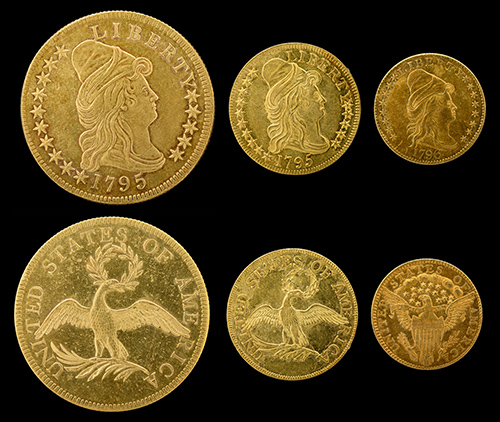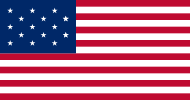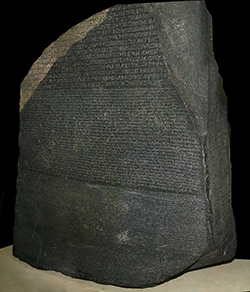MENU
The Electronic Scholarly Publishing Project: Providing access to classic scientific papers and other scholarly materials, since 1993. More About: ESP | OUR CONTENT | THIS WEBSITE | WHAT'S NEW | WHAT'S HOT
Comparative Timelines
The ESP Timeline (one of the site's most popular features) has been completely updated to allow the user to select (using the timeline controls above each column) different topics for the left and right sides of the display.
Select:
New Left Column
New Left Column
Dates
Decade
New Right Column
New Right Column
(no entry for this year)
1790
First U.S. census is conducted, showing a population of 3,939,214.
Society of Friends petitions Congress for abolition of slavery.
The first ten amendments to the US Constitution — The Bill of Rights — are ratified.
Washington, D.C., founded as the capitol of the United States.
 Luigi Galvani announces that electricity applied to severed frog's legs causes them to twitch and that frogs legs twitch in the presence of two different metals with no electric current present. The latter discovery eventually leads to Alessandro Volta's developing the electric battery.
Luigi Galvani announces that electricity applied to severed frog's legs causes them to twitch and that frogs legs twitch in the presence of two different metals with no electric current present. The latter discovery eventually leads to Alessandro Volta's developing the electric battery.
 Pierre Prévost develops his theory of exchanges of radiation of heat. He correctly shows that cold is merely the absence of heat and that all bodies continually radiate heat. If they seem not to radiate heat, it means that they are in heat equilibrium with their environment.
Pierre Prévost develops his theory of exchanges of radiation of heat. He correctly shows that cold is merely the absence of heat and that all bodies continually radiate heat. If they seem not to radiate heat, it means that they are in heat equilibrium with their environment.
1791
Vermont admitted as 14th state (first addition to the original thirteen colonies).
(no entry for this year)
1792
 The Coinage Act of 1792 (also known as the Mint Act; officially: An act establishing a mint, and regulating the Coins of the United States), passed by the United States Congress on April 2, 1792, created the United States dollar as the country's standard unit of money, established the United States Mint, and regulated the coinage of the United States. This act established the silver dollar as the unit of money in the United States, declared it to be lawful tender, and created a decimal system for U.S. currency. The Act specified the issuing of three gold coins comprising a $10 gold coin called an "eagle", a $5 coin called a "half eagle", and a $2.5 coin called a "quarter eagle". The Act also authorized construction of a mint building in Philadelphia, the nation's capital at the time. This was the first federal building erected under the United States Constitution. Adjusted for inflation, the ten-dollar coin would be worth $231.00 in today's money. As collector's items, these gold coins have sold for more than $100,000 each.
The Coinage Act of 1792 (also known as the Mint Act; officially: An act establishing a mint, and regulating the Coins of the United States), passed by the United States Congress on April 2, 1792, created the United States dollar as the country's standard unit of money, established the United States Mint, and regulated the coinage of the United States. This act established the silver dollar as the unit of money in the United States, declared it to be lawful tender, and created a decimal system for U.S. currency. The Act specified the issuing of three gold coins comprising a $10 gold coin called an "eagle", a $5 coin called a "half eagle", and a $2.5 coin called a "quarter eagle". The Act also authorized construction of a mint building in Philadelphia, the nation's capital at the time. This was the first federal building erected under the United States Constitution. Adjusted for inflation, the ten-dollar coin would be worth $231.00 in today's money. As collector's items, these gold coins have sold for more than $100,000 each.
U.S. postal service created; postage 6–12 cents, depending on distance. (In today's dollars, that would be somewhere between $1.40 and $3.00.)
Captain George Vancouver claims Puget Sound for Britain.
France declares war on Austria, starting French Revolutionary Wars.
The French Republic is proclaimed.
Twenty-four merchants form New York Stock Exchange at 70 Wall Street.
(no entry for this year)
1793
To enforce Article IV, Section 2, the U.S. Congress enacts the Fugitive Slave Law. It allows slaveowners to cross state lines to recapture their slaves. They must then prove ownership in a court of law. In reaction, some Northern states pass personal liberty laws, granting the alleged fugitive slaves the rights to habeas corpus, jury trials, and testimony on their own behalf. These Northern state legislatures also pass anti-kidnapping laws to punish slave-catchers who kidnap free blacks, instead of fugitive slaves.
 King Louis XVI of France is executed.
King Louis XVI of France is executed.
 Alessandro Volta demonstrates that the electric force observed by Galvani is not connected with living creatures, but can be obtained whenever two different metals are placed in a conducting fluid.
Alessandro Volta demonstrates that the electric force observed by Galvani is not connected with living creatures, but can be obtained whenever two different metals are placed in a conducting fluid.
1794
Slavery abolished in the French colonies.
(no entry for this year)
1795
 The US flag is modified to have fifteen stars and fifteen stripes, reflecting the addition of two new states: Vermont and Kentucky. This is the only US flag to have other than thirteen stripes.
The US flag is modified to have fifteen stars and fifteen stripes, reflecting the addition of two new states: Vermont and Kentucky. This is the only US flag to have other than thirteen stripes.
(no entry for this year)
1796
George Washington declines a third term as President, gives his Farewell Address.
Henry Cavendish determines the mass of Earth by measuring the gravity between two small masses and two large masses. This gives the gravitational constant G, which was the only unknown in Newton's equations. Solving for G enables Cavendish to establish that Earth is about 5.5 times as dense as water.
 Enquiry concerning the source of heat which is excited by friction by Count Rumford (Benjamin Thompson) describes his experiments with boring cannons that show that the caloric theory of heat cannot be true, and that heat should be considered a kind of motion.
Enquiry concerning the source of heat which is excited by friction by Count Rumford (Benjamin Thompson) describes his experiments with boring cannons that show that the caloric theory of heat cannot be true, and that heat should be considered a kind of motion.
1798
Napoleon invades Egypt and defeats the Egyptians at the Battle of the Pyramids.
(no entry for this year)
1799
 The Rosetta Stone is discovered in Egypt. The stone is a fragment of an Egyptian stele with the same inscription in three texts: ancient Egyptian hieroglyphs, Egyptian demotic script, and Greek. This side-by-side translation allows historians to translate ancient Egyptian hieroglyphs for the first time.
The Rosetta Stone is discovered in Egypt. The stone is a fragment of an Egyptian stele with the same inscription in three texts: ancient Egyptian hieroglyphs, Egyptian demotic script, and Greek. This side-by-side translation allows historians to translate ancient Egyptian hieroglyphs for the first time.
 Napoleon Bonaparte becomes First Consul and seizes power in France.
Napoleon Bonaparte becomes First Consul and seizes power in France.
ESP Quick Facts
ESP Origins
In the early 1990's, Robert Robbins was a faculty member at Johns Hopkins, where he directed the informatics core of GDB — the human gene-mapping database of the international human genome project. To share papers with colleagues around the world, he set up a small paper-sharing section on his personal web page. This small project evolved into The Electronic Scholarly Publishing Project.
ESP Support
In 1995, Robbins became the VP/IT of the Fred Hutchinson Cancer Research Center in Seattle, WA. Soon after arriving in Seattle, Robbins secured funding, through the ELSI component of the US Human Genome Project, to create the original ESP.ORG web site, with the formal goal of providing free, world-wide access to the literature of classical genetics.
ESP Rationale
Although the methods of molecular biology can seem almost magical to the uninitiated, the original techniques of classical genetics are readily appreciated by one and all: cross individuals that differ in some inherited trait, collect all of the progeny, score their attributes, and propose mechanisms to explain the patterns of inheritance observed.
ESP Goal
In reading the early works of classical genetics, one is drawn, almost inexorably, into ever more complex models, until molecular explanations begin to seem both necessary and natural. At that point, the tools for understanding genome research are at hand. Assisting readers reach this point was the original goal of The Electronic Scholarly Publishing Project.
ESP Usage
Usage of the site grew rapidly and has remained high. Faculty began to use the site for their assigned readings. Other on-line publishers, ranging from The New York Times to Nature referenced ESP materials in their own publications. Nobel laureates (e.g., Joshua Lederberg) regularly used the site and even wrote to suggest changes and improvements.
ESP Content
When the site began, no journals were making their early content available in digital format. As a result, ESP was obliged to digitize classic literature before it could be made available. For many important papers — such as Mendel's original paper or the first genetic map — ESP had to produce entirely new typeset versions of the works, if they were to be available in a high-quality format.
ESP Help
Early support from the DOE component of the Human Genome Project was critically important for getting the ESP project on a firm foundation. Since that funding ended (nearly 20 years ago), the project has been operated as a purely volunteer effort. Anyone wishing to assist in these efforts should send an email to Robbins.
ESP Plans
With the development of methods for adding typeset side notes to PDF files, the ESP project now plans to add annotated versions of some classical papers to its holdings. We also plan to add new reference and pedagogical material. We have already started providing regularly updated, comprehensive bibliographies to the ESP.ORG site.
ESP Picks from Around the Web (updated 06 MAR 2017 )
Old Science

Weird Science

Treating Disease with Fecal Transplantation
Fossils of miniature humans (hobbits) discovered in Indonesia

Dinosaur tail, complete with feathers, found preserved in amber.
Astronomy

Mysterious fast radio burst (FRB) detected in the distant universe.